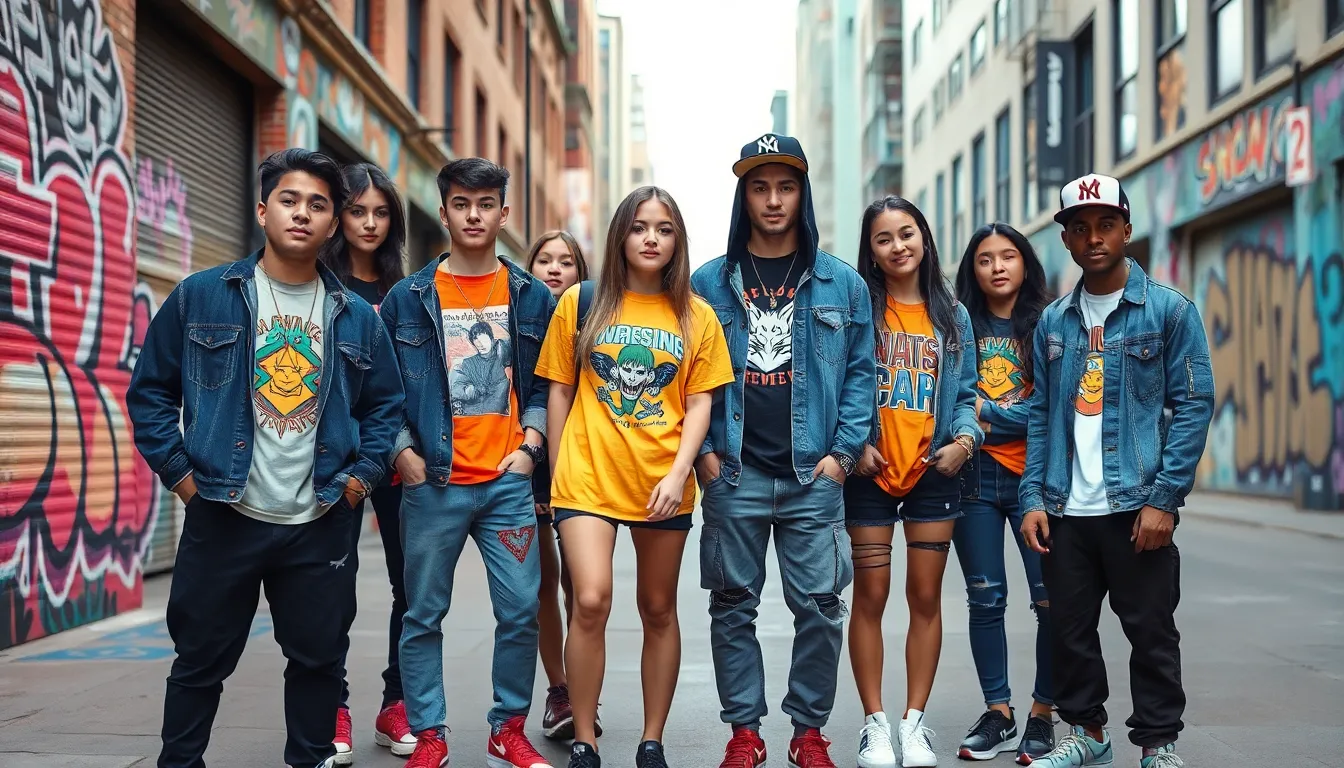Streetwear has evolved from niche subcultures to a global phenomenon, shaping not just fashion but also art and music. Its roots in skate, hip-hop, and punk cultures have created a unique blend of influences that resonate with diverse audiences. As a result, streetwear isn’t just about clothing; it’s a lifestyle and a form of self-expression.
The rise of social media has amplified streetwear’s reach, allowing brands and designers to connect with fans directly. This dynamic interaction has led to collaborations that push boundaries and redefine trends. Understanding the influences behind streetwear reveals a rich tapestry of creativity that continues to inspire new generations.
Table of Contents
ToggleOverview of Streetwear Influences
Streetwear encompasses various influences that shape its identity and evolution. Understanding these influences highlights the genre’s complex character.
- Skate Culture
Skate culture originates from the streets of California, promoting casual, functional clothing suited for an active lifestyle. Brands like Supreme and Thrasher reflect this heritage, merging practicality with style.
- Hip-Hop Movement
The hip-hop movement impacts streetwear significantly, intertwining music, fashion, and culture. Iconic figures such as Run-D.M.C. and Kanye West popularized bold styles, introducing oversized garments and vibrant color palettes.
- Punk Aesthetic
The punk aesthetic contributes a rebellious spirit to streetwear, incorporating elements such as graphic tees, leather jackets, and DIY fashion. This influence promotes individuality and nonconformity in clothing choices.
- Art and Design
Art and design permeate streetwear, with collaborations between designers and artists producing limited-edition pieces. Influences from contemporary art, urban graffiti, and pop culture provide unique graphic elements that distinguish collections.
- Technology and Social Media
Technology and social media revolutionize streetwear visibility, facilitating brand promotion and consumer engagement. Platforms like Instagram and TikTok allow brands to reach global audiences rapidly, enabling viral marketing strategies.
- Sportswear Trends
Sportswear trends fuse comfort with fashion, incorporating performance fabrics into everyday wear. Athletic brands like Nike and Adidas expand their offerings to include street-inspired collections, appealing to a broad demographic.
- Globalization
Globalization contributes to the cross-pollination of styles, allowing streetwear to draw inspiration from diverse cultures. International brands often blend regional aesthetics with Western influences, resulting in innovative designs.
These influences collectively cultivate a vibrant streetwear landscape, embodying a lifestyle that transcends conventional fashion boundaries.
Historical Context of Streetwear

Streetwear emerged from diverse subcultures and transformed into a significant global fashion movement. Understanding its roots and evolution demonstrates how streetwear became a vital form of self-expression.
Origins of Streetwear
Streetwear originated in the late 1970s and early 1980s in urban areas of the United States. Skate culture played a crucial role, with brands like Billabong and Stüssy pioneering casual, functional clothing for skaters. The hip-hop movement also contributed to streetwear’s foundation, as artists like Run-DMC began integrating fashion into their music personas. Punk culture further infused streetwear with its rebellious spirit, favoring graphic tees, denim jackets, and DIY aesthetics. These elements converged, creating a unique style that resonated with youth seeking authenticity and individuality.
Evolution Through the Decades
Streetwear evolved significantly through the 1980s and 1990s. The 1980s saw the influence of graphics and bold logos, exemplified by brands like Supreme, which launched in 1994. The 1990s emphasized the connection between music and fashion, with iconic moments like Pharrell Williams’ influence on skate and hip-hop styles. The 2000s introduced collaborations with high-fashion designers, marking a crossover that blurred the lines between luxury and street. The rise of social media in the 2010s propelled streetwear to mainstream visibility, as influencers and brands harnessed digital platforms to showcase collections. Today’s streetwear continues evolving, integrating global aesthetics and advancing through sustainability trends, maintaining its position as a dynamic and influential force in fashion.
Key Brands and Designers
Streetwear thrives on innovation and influence, which stems from notable brands and visionary designers. The following sections highlight iconic streetwear labels and influential designers who have significantly shaped this dynamic fashion landscape.
Iconic Streetwear Labels
- Supreme: Founded in 1994, Supreme quickly became synonymous with streetwear culture. Its limited releases and collaborations with artists and brands create high demand and exclusivity.
- Off-White: Launched by Virgil Abloh in 2012, Off-White combines streetwear aesthetics with luxury design. The label’s distinctive use of quotation marks and bold graphics has attracted a global audience.
- Stüssy: Originating in the early 1980s, Stüssy played a vital role in establishing skate culture in streetwear. Its surf and skate-inspired designs resonate with a sense of rebellion and authenticity.
- A Bathing Ape (BAPE): BAPE, founded in 1993 by Nigo, revolutionized streetwear with its bold camo patterns and ape logo. The brand’s collaborations with celebrities and other labels maintain its iconic status.
- Palace: Established in 2009, Palace’s blend of skate culture and street fashion immediately garnered attention. Its unique graphics and retro-inspired designs appeal to a younger demographic.
Influential Designers in Streetwear
- Virgil Abloh: As the founder of Off-White and artistic director of Louis Vuitton’s menswear, Virgil Abloh bridged the gap between streetwear and high fashion. His creative vision redefined luxury’s relationship with urban culture.
- Willy Chavarria: Known for celebrating Chicano culture, Willy Chavarria infuses social commentary into his designs. His emphasis on inclusivity and body positivity fosters a diverse approach to streetwear.
- Rhuigi Villaseñor: Rhuigi, the founder of Rhude, integrates personal storytelling into his collections. His attention to detail and high-quality materials elevates streetwear into a refined art form.
- Jerry Lorenzo: As the founder of Fear of God, Jerry Lorenzo’s designs balance luxury and street elements. His minimalist aesthetic and focus on tailored fits continue to influence contemporary fashion.
- Shayne Oliver: The founder of Hood By Air, Shayne Oliver challenged traditional gender norms and fashion conventions. His boundary-pushing designs explore identity and culture within the streetwear realm.
These brands and designers play a pivotal role in shaping streetwear’s identity, pushing the genre beyond mere clothing into a complex cultural movement.
Cultural Impact of Streetwear
Streetwear significantly impacts various cultural domains, most notably music and art. Its dynamic nature creates a fusion of styles that resonates with diverse audiences.
Streetwear and Music
Streetwear and music share a symbiotic relationship, influencing each other continuously. Hip-hop artists like Kanye West and Pharrell Williams incorporate streetwear into their personal brands, shaping fashion trends within the genre. Iconic moments, such as Run-DMC partnering with Adidas, exemplify how music and fashion intersect. Concerts and music videos frequently showcase streetwear brands, making them integral to an artist’s image. Festivals like Coachella highlight streetwear’s presence, as attendees embrace the genre’s style, reflecting their identities and values through clothing choices.
Streetwear in Art and Design
Streetwear heavily influences contemporary art and design, forging a connection between clothing and creative expression. Collaborations between streetwear brands and artists—such as KAWS and Supreme—elevate clothing to artistic statements. These partnerships produce limited-edition items that blur the lines between fashion and art, attracting collectors and enthusiasts alike. Streetwear draws inspiration from urban art forms like graffiti, embedding bold graphics and vibrant visuals into designs. This fusion creates unique pieces that resonate with consumers seeking authenticity and individuality in their attire. As streetwear culture evolves, its intersection with art and design continues to inspire new trends and movements.
Streetwear in Popular Media
Streetwear’s influence permeates popular media, shaping visual culture through film, television, and celebrity endorsements. This interplay not only enhances streetwear’s visibility but also solidifies its cultural significance.
Film and Television Representations
Film and television frequently showcase streetwear, portraying it as an essential part of contemporary youth culture. Titles such as “Do the Right Thing” and “The Fresh Prince of Bel-Air” feature characters in iconic streetwear, illustrating its integration into daily life. Recent series like “On My Block” and “Euphoria” highlight modern expressions of style, reflecting diversity and authenticity. These portrayals resonate with audiences, driving demand for brands that epitomize the fashion language of street culture.
Celebrity Endorsements
Celebrities amplify streetwear’s reach, acting as influential ambassadors for brands. High-profile figures like Travis Scott and Rihanna promote streetwear through collaborations and personal styles, attracting attention from their fanbases. Endorsements from athletes such as LeBron James and entertainers like Billie Eilish carve new pathways for streetwear in mainstream fashion. These partnerships not only bolster brand visibility but also validate streetwear’s status as a trendsetting force in fashion and popular culture.
Streetwear’s influence is undeniable as it continues to shape fashion music and art in profound ways. Its journey from niche subcultures to a global phenomenon showcases the power of self-expression and community. The fusion of various cultural elements has created a vibrant landscape that resonates with youth seeking authenticity.
As streetwear evolves it embraces sustainability and global aesthetics while maintaining its rebellious spirit. This dynamic movement not only reflects current trends but also inspires future generations to push boundaries. With its roots deeply embedded in urban culture streetwear is more than just a style—it’s a lifestyle that celebrates individuality and creativity.




